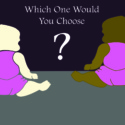The doll experiment has been resurrected repeatedly for over the past 80 years.
For those of you not familiar with the doll experiment, here’s a quick run-through. In the 1940s, Kenneth and Mamie Clark – African-American psychologists – became famous for conducting a research experiment on children and their attitudes towards race. They would present children with dolls who were nearly identical except for the fact that one had a lighter skin tone and blonde hair and the other had a darker skin tone and dark hair. They would ask the children “which doll is prettier? Which doll has nicer hair?” The majority of the time the lighter doll came out on top.
Over 80 years later, so much, yet not enough, has changed.
Colourism is something that has inflicted Black communities from the moment we were colonized by White slave masters. Tamone Scarlett, a social justice worker who works primarily with Black and Indigenous LGBTQ2S+ (Lesbian, Gay, Bisexual, Transgendered, Queer, two-Spirited) youth, summed it up as the “house slave mentality.”
Scarlett explained stories of colourism affected childhood, “I have a very distinct memory of my own mother telling me ‘I forbid you to play when the sun is high in the sky. That’s when the sun’s rays are the strongest and that’s when you’ll become the blackest.’ I never really understood why that wasn’t okay.”
“My mother wanted me to be perceived as having the highest worth because [I was] already a Black person and Black people are viewed as subhuman.”
Scarlett, who is of Jamaican descent, acknowledges that colourism saturates the culture. She explained that many hold the ideology that the closer one can get to whiteness, the more dignity, self-worth, and humanity they will have.
The Jamaican Observer wrote that skin-bleaching has reached “dangerous proportions” and “hardcore bleachers use illegal ointments smuggled into the Caribbean country that contain toxins like mercury.” The issue of colourism is not made any easier when you have home-town artists like Vybz Kartel praising the practice in their music and in interviews.
Scarlett herself has never felt pressured into using skin-bleaching products, but her own experience is not a reflection of the reality in Jamaica.
Coloured representation in media has a long and difficult history. There are those who argue that having a Black-centric entertainment company like BET (Black Entertainment Television) is unfair. For those who are still using that argument, I’m here to inform you that the entire history of mainstream entertainment and television was white-centric.
“When I was a kid … it was all white everything except for BET. That was the only place where people looked like me, but then again it was a very stereotyped, homogenized experience.” Scarlett said.
Many other people who identify as Black would agree that mainstream entertainment has never really taken the time to explore and tell the stories of black communities that are different from one another.
Above all colourism impacts our youth. Scarlett believes that it will be a while before we see a generational shift. In her line of work, she still observes how the shade of someone’s skin effects their experiences.
“There is this saying that ‘the blacker the berry the sweeter the juice but the blacker the baby the tighter the noose,’” said Scarlett.
“They have a beautiful rhetoric with [role models] like Zendaya and Amandla Stenberg and other kids their age but there is still this disconnect,” said Scarlett.
She believes that it’s something that’s put upon them from the generation that raised them and that will most likely be put upon the next generation until hopefully it trickles out.
“Sometimes [youth] don’t necessarily understand that race always ends up coming first in terms of identity. Although those experiences [as members of the LGBTQ2S+ community] are very real, they end up erasing their own racialized experiences.”
Graphic b




